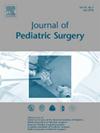Tracheobronchopexy to Avoid Tracheostomy in Esophageal Atresia Patients With Severe Life-Threatening Tracheobronchomalacia
IF 2.4
2区 医学
Q1 PEDIATRICS
引用次数: 0
Abstract
Background
Esophageal atresia (EA) is associated with tracheobronchomalacia (TBM), which in its most severe form, causes blue spells, brief resolved unexplained events (BRUEs) that can require cardiopulmonary resuscitation (CPR), and positive pressure ventilation (PPV) or ventilator dependence, often requiring tracheostomy. We study the role of tracheobronchopexy, as an alternative to tracheostomy, in EA patients with severe life-threatening TBM.
Methods
We reviewed EA patients who underwent tracheobronchopexy for blue spells, BRUEs, and failure to wean PPV or extubate from February 2013 to September 2021 at two institutions. Patient characteristics, surgical techniques, and respiratory outcomes were reviewed.
Results
80 EA patients (most Gross type C 92.5 %) underwent 91 tracheobronchopexies at median age 6 (IQR 3–14) months for blue spells/BRUEs (53 %), PPV (21 %), and ventilator dependence (26 %). On preoperative dynamic bronchoscopy, most (90 %) demonstrated complete airway collapse. Surgical approach for tracheobronchopexy was posterior (73 %), anterior (23 %), and simultaneous posterior and anterior (4 %). Tracheobronchopexy included thoracic trachea alone (58 %), trachea and bronchi (41 %), and bronchi alone (1 %). At latest follow up of median 39 (IQR 14–64) months, there were no recurrent blue spells/BRUEs (p < 0.001) and significantly reduced PPV and ventilator dependence (p < 0.001). Nearly all patients (n = 75, 94 %) avoided tracheostomy. Mortality was 5 %, one 30-day operative mortality and three long-term mortalities related to underlying comorbidities.
Conclusions
In EA patients with severe life-threatening TBM, tracheobronchopexy significantly reduces blue spells/BRUEs, PPV, and ventilator dependence, and avoids tracheostomy. This surgical strategy should be considered the treatment of choice for EA patients with severe life-threatening TBM symptoms.
Level of Evidence
Level IV Treatment Study.
食管闭锁合并严重危及生命的气管支气管软化患者行气管支气管切开术以避免气管造瘘。
背景:食管闭锁(EA)与气管支气管软化症(TBM)相关,其最严重的形式会导致蓝色发作,短暂的无法解释的解决事件(brue),可能需要心肺复苏(CPR)和正压通气(PPV)或呼吸机依赖,通常需要气管切开术。我们研究了气管支气管切开术在EA合并严重危及生命的TBM患者中作为气管切开术的替代方法的作用。方法:我们回顾了2013年2月至2021年9月在两家机构因蓝期、布鲁斯和未能断奶PPV或拔管而接受气管支气管切开术的EA患者。回顾了患者特征、手术技术和呼吸结果。结果:80例EA患者(大多数为Gross C型92.5%)在中位年龄6 (IQR 3-14)个月时接受了91次气管支气管切断术,原因是蓝色发作/BRUEs (53%), PPV(21%)和呼吸机依赖(26%)。在术前动态支气管镜检查中,大多数(90%)表现为完全气道塌陷。气管支气管固定术的手术入路为后路(73%)、前路(23%)和前后路同时入路(4%)。气管支气管切开术包括单独胸气管(58%)、气管和支气管(41%)和单独支气管(1%)。在最近的中位随访39 (IQR 14-64)个月时,没有复发的蓝色发作/布鲁斯(p)。结论:在EA合并严重危及生命的TBM患者中,气管支气管切开术可显著减少蓝色发作/布鲁斯、PPV和呼吸机依赖,并避免气管切开术。对于有严重危及生命的TBM症状的EA患者,应考虑选择这种手术策略。证据等级:IV级治疗研究。
本文章由计算机程序翻译,如有差异,请以英文原文为准。
求助全文
约1分钟内获得全文
求助全文
来源期刊
CiteScore
1.10
自引率
12.50%
发文量
569
审稿时长
38 days
期刊介绍:
The journal presents original contributions as well as a complete international abstracts section and other special departments to provide the most current source of information and references in pediatric surgery. The journal is based on the need to improve the surgical care of infants and children, not only through advances in physiology, pathology and surgical techniques, but also by attention to the unique emotional and physical needs of the young patient.

 求助内容:
求助内容: 应助结果提醒方式:
应助结果提醒方式:


